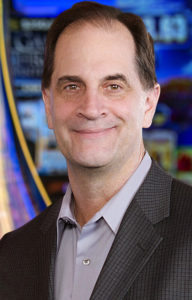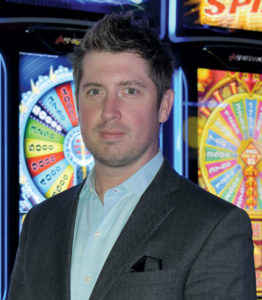How to drive more revenue on the slot floor
Every issue we’ve asked slot suppliers what tools and advice slot directors can benefit from that perhaps they’re not taking full advantage of. We’ve covered marketing solutions, progressive hit levels and banking strategies (please visit www.tgandh.com to view these insightful solutions).
In this issue, we’ve asked our panel, “What are the top three things that Tribal casinos could change on the slot floor to drive more revenue?
 James Starr
James Starr
President
VGT an Aristocrat Company
“The first, second and third things we recommend changing on the Tribal casino floor are, in order, adding Class II games, adding Class II games and adding Class II games. All too often and in far too many places in the country, Tribal casinos are not taking full advantage of the Class II opportunities available today.
“States such as Oklahoma and Washington are leading examples where there is a healthy mix of Class II and Class III products. Tribal casinos can provide a better player experience by having a healthy mix of Class II and Class III games. Operators in all Tribal operations should look at the opportunity that Class II gives them to diversify their casino floor. A mix of Class II and Class III games provides an experience that is attractive to a wide range of player types and tastes.
“In recent years, Class II games from many suppliers, like Aristocrat and VGT, have been more thoughtfully designed to give the player a better overall gaming experience. For example, Aristocrat’s popular The Walking Dead franchise is being migrated into the Class II space with an all-new game that was created specifically for Class II. We’ve also launched Welcome to Fantastic Jackpots as a Class II only game and are moving VGT favorites such as Hunt for Neptune’s Gold from our legacy platform to our Ovation video platform, which allows us to create a better player experience for Class II. Expanding the Class II offering will empower operators to expand their offering to players who like a certain type of game, and to reap the benefits of Class II gaming.”
 Mike Trask
Mike Trask
Director of Product Marketing & Strategy
Ainsworth
“One of the biggest things that we have encouraged our Tribal casino partners to do is to periodically review slot footprints on a game by game basis with our Product Analyst. “We started to do this with our Class II footprint to understand how our AnyBet Progressive Jackpot levels impacted gameplay. It was successful enough that we have begun trying to duplicate the process on all kinds of games across sold and leased content in Class II, Class III, Washington State and Historical Horse Racing markets.
“The manufacturer reviewing the casino floor together with the guest can really help with understanding properties’ strategies and goals, which is helpful for both parties. Often there are areas for easy revenue increases with relatively minor changes to banking, configurations or content. It’s also important to explore the profitability of owned games in comparison to participation-style games. Every property is different and there is no one right answer. But often the slot providers can help optimize existing products to maximize player interest. It can be amazing the results to coin-in with modified bet structures, adjusted progressive levels or a simple content refresh.”
 Dan Schrementi
Dan Schrementi
VP Gaming Sales & Marketing
Incredible Technologies
“When it comes to driving revenue, Tribes have unique advantages over commercial operators. The best example of this is the ability to augment product on their floor with a mix of Class II. As technology has increased, the ability to add Class II product without diminishing performance is finally there, coming with many advantages to the Tribe’s bottom line. Another opportunity for Tribal operators comes from the need that slot manufacturers have for test bank data.
“Tribes can be more flexible with what performance data is shared (and how often), and in return gain access to the newest games sooner for an exclusive edge over their competition. Additionally, often machines used in the test are offered at advantageous pricing. My final suggestion for Tribal operators is using analytics to fine tune RTP and bet structure. Commercial casinos are under much greater pressure to lock RTP at the tightest rates, while Tribal operators tend to have more flexibility. It would be a mistake to not use BI tools to measure these metrics and optimize in ways that your competition cannot – dare I say, even if that means decreasing slot hold.”
 Damien Greig
Damien Greig
Executive Director, Product Management
Scientific Games with contributions by
Rob Bone, Vice President, Electronic Table Games and Mike Owen, Director, Sales
“The typical player in most Tribal casinos tends to be a ‘local’ player who visits their favorite casino multiple times a week and wants to play games that have a medium to high volatility rating, a different win distribution to the entertainment time-at-device style of games. The locals market games are usually designed for dual-screen cabinets and in recent years have crossed over to the ever-popular vertical cabinet stream. Games can range from lines to ways to progressives to standalones and all come with proven game mechanics. Our new cabinet ‘Matrix’ that we are launching at NIGA was developed specifically for these types of games with this specific player in mind. This cabinet was optimized for the gambler with its ‘no frills’ aesthetics and proven content for the mature ‘locals’ repeat-play market, where players like their games with a bit more zing for their buck.
“We would also recommend finding ways to introduce new products and innovations to the traditional high limit or higher denomination players. We see many rooms or areas with dated, albeit proven, product offerings, but few casinos are finding ways to introduce newer titles, brands and bet configurations to those areas/players for fear of displacing older, proven products. While we don’t recommend completely discarding the old, it would be helpful to find new ways to introduce the new.
“Finally, Bet Configurations can be optimized. Many products are configured with bet structures far beyond normal or established comfort levels of guests. When this happens, guests may be able to enter the game at a low enough cost to cover, however, they cannot scale their bets up to a level beyond one or two per line. For example, offering 50-line games at $0.01 at a one to two or even three per line may be just fine for most players, however, very few can play beyond this level and many games are set up to 10 credits per line. However, when like configurations grow and denominations grow, these bets become unaffordable. In short, guests are looking for the most ways to bet $1 to $2.50 on average, but few can stretch beyond this.”
